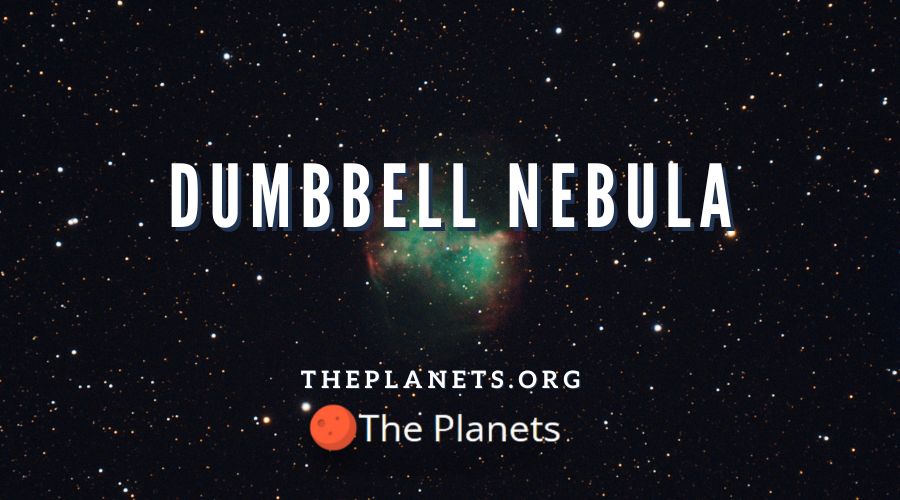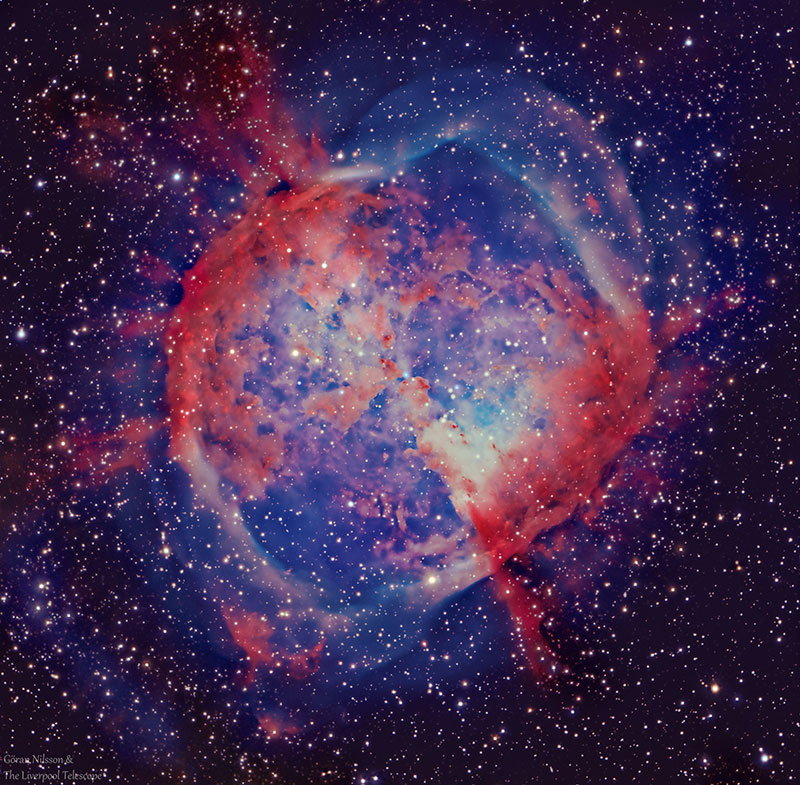
Dumbbell Nebula Profile
Designation: M27, NGC 6853
Radius: 1.44 lightyears
Distance: 1227 lightyears
Constellation: Vulpecula

The Dumbbell Nebula puzzled astronomers for generations. The French astronomer Charles Messier (1730 – 1814) began cataloging the “nebulous objects” he found. He had mistakenly labeled some of them as comets. Upon realizing his error, he began his list, the Messier Catalogue, to prevent other astronomers from making the same mistake.
Messier found the Dumbbell Nebula in 1764, and he gave it the designation M27. During his career, Messier found 110 astronomical objects. Messier described M27 as an oval nebula that had no stars.
The English astronomer William Huggins (1824-1910) deduced the nebula’s true nature in 1864. He wrote that nebulae, in general, were not groups of suns, but gigantic masses of luminous gases.
Facts About the Dumbbell Nebula
- The Dumbbell Nebula was the first planetary nebula to be discovered.
- A planetary nebula is formed by ionized gases produced by red giants that have shed their outer layers. It is round and thus reminded early astronomers of a planet.
- This nebula is being produced by a very hot white dwarf that has been ejecting gas for thousands of years. That white dwarf is the remaining core of the original red giant.
- A Soviet astronomer, O.N. Chudowitchera, estimated that the nebula’s brightest part is expanding 6.8 arc seconds every century which would make it 3,000 to 4,000 years old.
- Robert Burnham estimated that the nebula’s brightest part was expanding 1.0 arc seconds every second which would make it around 48,000 years old.
- Another name for the Dumbbell Nebula is the “Apple Core Nebula.”
- The nebula has a visual magnitude of 7.5, which means it can be readily seen with a telescope or even binoculars.
- September is the best month for observing the nebula.
- The Hubble Space Telescope has taken pictures of the Dumbbell Nebula.
- The Hubble Space Telescope also provided the current estimated distance for the Dumbbell Nebula; earlier estimates had ranged from 490 to 3500 lightyears.
- The different colors indicate different gases: green indicates hydrogen, blue indicates oxygen, and red indicates nitrogen and sulfur.
- William Herschel (1738 – 1822) thought the nebula looked like an hourglass or dumbbell and thus gave it its best-known name. He was also the first person to identify the Dumbbell Nebula as a planetary nebula.
- The Dumbbell Nebula is the second-largest known planetary nebula; only the Helix Nebula is bigger.
- Its white dwarf is the largest known with a radius of 0.055 solar radii and 0.56 solar masses. Its temperature is estimated to be 85,000 K (152,540.33 F).
- The white dwarf may have a yellow companion star.
- The nebula produces infrared light as well as visible light.
- Dumbbell Nebula is much brighter than its star because the star produces mainly non-visible radiation.
- This Nebula is about 100 times as bright as the Sun.
How to Find It
One way to look for the Dumbbell Nebula is to look for constellations in its “neighborhood.” Cygnus and Aquila are both large, cross-shaped constellations that can be spotted even in cities. After finding them, it’s now time to look for smaller constellations in the area. These include Lyra and Delphinus; the latter is small and shaped like a kite. A third small constellation, Sagitta, is shaped like an arrow.
Vulpecula, the constellation containing the Dumbbell Nebula, will be between all of the constellations listed, and the nebula will be near Sagitta.
Definitions
Solar mass – The solar mass is a unit of measurement based on the mass of the Sun, which is approximately 2 x 1030 kg. It is used to measure the mass of other stars, nebulae, clusters, and even galaxies.
Solar radius – A solar radius is a unit of measurement used to compare a star’s size to that of the Sun, which has a radius of 695,700 km (432,000 miles). Not surprisingly, the white dwarf at the center of the Crab Nebula is a lot smaller than the Sun.